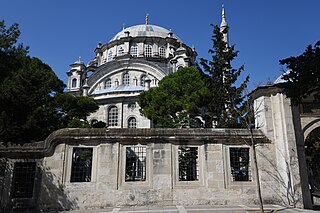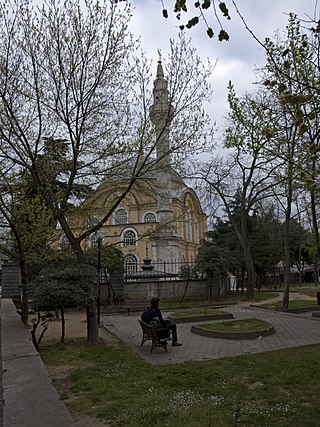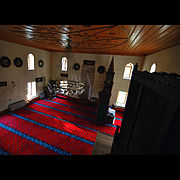
A minaret is a type of tower typically built into or adjacent to mosques. Minarets are generally used to project the Muslim call to prayer (adhan), but they also served as landmarks and symbols of Islam's presence. They can have a variety of forms, from thick, squat towers to soaring, pencil-thin spires.

The Blue Mosque in Istanbul, also known by its official name, the Sultan Ahmed Mosque, is an Ottoman-era historical imperial mosque located in Istanbul, Turkey. A functioning mosque, it also attracts large numbers of tourist visitors. It was constructed between 1609 and 1616 during the rule of Ahmed I. Its Külliye contains Ahmed's tomb, a madrasah and a hospice. Hand-painted blue tiles adorn the mosque’s interior walls, and at night the mosque is bathed in blue as lights frame the mosque’s five main domes, six minarets and eight secondary domes. It sits next to the Hagia Sophia, the principal mosque of Istanbul until the Blue Mosque's construction and another popular tourist site. The Blue Mosque was included in the UNESCO World Heritage Site list in 1985 under the name of "Historic Areas of Istanbul".

A minbar is a pulpit in a mosque where the imam stands to deliver sermons. It is also used in other similar contexts, such as in a Hussainiya where the speaker sits and lectures the congregation.

Mangalia, ancient Callatis, is a city and a port on the coast of the Black Sea in the south-east of Constanța County, Northern Dobruja, Romania.

Al-Masjid an-Nabawi, known in English as the Prophet's Mosque, is a mosque built by the Islamic prophet Muhammad in the city of Medina in the Al Madinah Province of Saudi Arabia. It was the second mosque built by Muhammad in Medina, after Quba Mosque, and is the second largest mosque and second holiest site in Islam, both titles ranking after the Masjid al-Haram in Mecca. The mosque is located at the heart of Medina and is a major pilgrimage site that falls under the purview of the Custodian of the Two Holy Mosques.

The Selimiye Mosque is an Ottoman imperial mosque, which is located in the city of Edirne, Turkey. The mosque was commissioned by Sultan Selim II, and was built by the imperial architect Mimar Sinan between 1568 and 1575. It was considered by Sinan to be his masterpiece and is one of the highest achievements of Islamic architecture as a whole and Ottoman architecture in particular.

Ortaköy Mosque or Büyük Mecidiye Camii in Beşiktaş, Istanbul, Turkey, is a mosque situated at the waterside of the Ortaköy pier square, one of the most popular locations on the Bosphorus. It was commissioned by the Ottoman sultan Abdülmecid I and its construction was completed around 1854 or 1856.

The Eyüp Sultan Mosque is in the Eyüp district of Istanbul, outside the city walls and near the Golden Horn. On a much older site, the present building dates from the beginning of the 19th century. The mosque complex includes a mausoleum marking the spot where Ebu Eyüp el-Ansari, the standard-bearer and companion of the Prophet Muhammad, is said to have been buried.

Islam in Romania is followed by only 0.3 percent of population, but has 700 years of tradition in Northern Dobruja, a region on the Black Sea coast which was part of the Ottoman Empire for almost five centuries. In present-day Romania, most adherents to Islam belong to the Tatar and Turkish ethnic communities and follow the Sunni doctrine. The Islamic religion is one of the 18 rites awarded state recognition.

The Yeni Valide Mosque is an 18th-century Ottoman mosque in the Üsküdar district of Istanbul, Turkey.

The Grand Mosque of Constanța, originally known as the Carol I Mosque, is a mosque in Constanța, Romania. It is listed as an historic monument by the Romanian National Institute of Historical Monuments.

Sokollu Mehmed Pasha Mosque is a 16th-century Ottoman mosque in the Kadırga neighborhood in Fatih district, Istanbul, Turkey. It was commissioned jointly by the grand vizier Sokollu Mehmed Pasha and his wife İsmihan Sultan. It was designed by the imperial architect Mimar Sinan and completed in 1571/2. The mosque is noted for the fine quality of the Iznik tiles that decorate the interior walls.

The Great Mosque of Aleppo is the largest and one of the oldest mosques in the city of Aleppo, Syria. It is located in al-Jalloum district of the Ancient City of Aleppo, a World Heritage Site, near the entrance to Al-Madina Souq. The mosque is purportedly home to the remains of Zechariah, the father of John the Baptist, both of whom are revered in Islam and Christianity. It was built in the beginning of the 8th century CE. However, the current building dates back to the 11th through 14th centuries. The minaret in the mosque was built in 1090, and was destroyed during fighting in the Syrian Civil War in April 2013.

The Grand Mosque of Bursa is a historic mosque in Bursa, Turkey. It was commissioned by the Ottoman Sultan Bayezid I to commemorate his great victory at the Battle of Nicopolis and built between 1396 and 1399. The mosque is a major monument of early Ottoman architecture and one of the most important mosques in the city, located in the heart of the old city alongside its historic markets.

The Nuruosmaniye Mosque is an 18th-century Ottoman mosque located in the Çemberlitaş neighbourhood of Fatih district in Istanbul, Turkey, which was inscribed in the Tentative list of World Heritage Sites in Turkey in 2016.

The Selimiye Mosque is a mosque in the district of Üsküdar in İstanbul, Turkey, near the Selimiye Barracks. It was commissioned by Ottoman Sultan Selim III and built between 1801 and 1805.

Altunizade Mosque, also known as İsmail Zühtü Pasha Mosque is a 19th-century Ottoman mosque located in Istanbul, Turkey.

The Sokollu Mehmed Pasha Mosque, also known as the Köprübaşı (Bridgehead) Mosque, is the ruin of a 16th-century Ottoman mosque located in Istanbul, Turkey.

The Yakovalı Hasan Paşa Mosque is a late 16th-century mosque in Pécs, southern Hungary. It was constructed when the region was part of the Turkish Ottoman Empire, around the same time as the main mosque of Pécs, the Mosque of Pasha Qasim. It was named after the local government official who commissioned the mosque, Yakovalı Hasan Paşa. It is thus one of the oldest mosques existing in Hungary today. The mosque is still active as a Muslim place of worship, and also houses a small exhibition centre for Turkish handicraft and historical artifacts documenting Hungary's Ottoman past.

Classical Ottoman architecture is a period in Ottoman architecture generally including the 16th and 17th centuries. The period is most strongly associated with the works of Mimar Sinan, who was Chief Court Architect under three sultans between 1538 and 1588. The start of the period also coincided with the long reign of Suleiman the Magnificent, which is recognized as the apogee of Ottoman political and cultural development, with extensive patronage in art and architecture by the sultan, his family, and his high-ranking officials. Ottoman architecture at this time was strongly influenced by Byzantine architecture, particularly the Hagia Sophia, and blended it with other influences to suit Ottoman needs. Architects typically experimented with different combinations of conventional elements including domes, semi-domes, and arcaded porticos. Successful architects such as Sinan demonstrated their skill through their meticulous attempts to solve problems of space, proportion, and harmony. Sinan's most important works include the Şehzade Mosque, Süleymaniye Mosque, and Selimiye Mosque. After his death, the classical style became less innovative and more repetitive. The 17th century still produced major works such as the Sultan Ahmed Mosque, but the social and political changes of the Tulip Period eventually led to a shift towards Ottoman Baroque architecture.
























